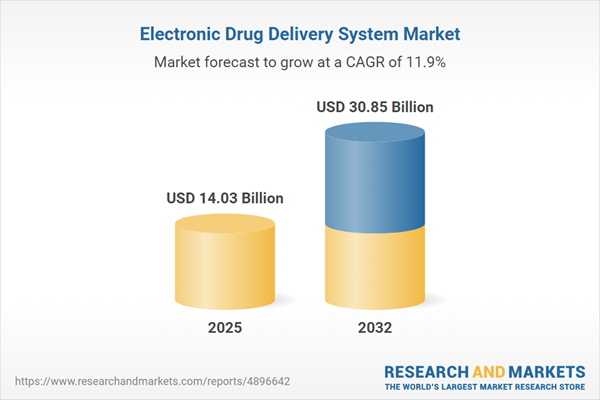Speak directly to the analyst to clarify any post sales queries you may have.
The electronic drug delivery system market is redefining how healthcare organizations approach medication management, offering digitally-enabled solutions that enhance patient engagement and streamline operational efficiency. Senior decision-makers are increasingly prioritizing these systems as foundational to next-generation clinical care strategies.
Market Snapshot: Growth and Momentum in the Electronic Drug Delivery System Market
The electronic drug delivery system market is reporting robust growth, valued at USD 12.56 billion in 2024 and advancing at a compound annual growth rate of 11.88%. This expansion is being driven by accelerated adoption of digital medication management tools and increasing integration of technology in clinical workflows. The market is projected to achieve a valuation of USD 30.85 billion by 2032, reflecting a steady increase in digital health investments, strong chronic disease management initiatives, and the rise of telehealth offerings. Technology partnerships and coordinated device ecosystems are becoming essential for organizations to remain adaptive and competitive across both inpatient and outpatient settings.
Scope & Segmentation of the Electronic Drug Delivery System Market
This comprehensive report provides senior executives with an actionable framework for strategic decision-making, investment, and innovation across all segments of the electronic drug delivery system industry. Each segment has relevance for executives assessing competitive positioning and clinical integration throughout global healthcare networks:
- Device Types: Incorporates auto injectors, inhalers, and insulin pumps designed to provide accurate, user-friendly medication delivery in hospital-centric and home-based care models.
- Additional Device Technologies: Covers advanced nebulizers, needle-free jet injectors, transdermal patches, and both glass and polymer pre-filled syringes, each supporting precise dosing and improving patient usability.
- Route of Administration: Includes inhalation, injection, ophthalmic, transdermal, intranasal, and intrathecal pathways, fostering versatility for diverse clinical requirements and specialty therapies.
- Application Areas: Supports disease states such as cardiovascular, diabetes, respiratory, autoimmune, oncology, and various chronic or acute conditions, ensuring effective therapy alignment across patient populations.
- End User: Implements solutions across ambulatory care centers, hospitals, specialty clinics, and home healthcare settings, empowering patients and optimizing workflow efficiency for providers.
- Distribution Channel: Features structured integration via hospital procurement processes, retail pharmacy networks, and online channels, enabling flexible and scalable supply chain operations.
- Geographic Coverage: Regional analysis provides insights into market trends spanning the Americas, Europe, Asia-Pacific, and Middle East and Africa, capturing local policy influences, reimbursement variations, and adoption patterns.
- Company Coverage: Examines major industry stakeholders including Medtronic plc, Becton Dickinson and Company, Baxter International Inc., B. Braun Melsungen AG, Smiths Group plc, Terumo Corporation, ICU Medical Inc., Insulet Corporation, Tandem Diabetes Care Inc., and Ypsomed AG.
Key Takeaways for Senior Decision-Makers
- Connected drug delivery platforms support real-time clinical data utilization, driving workflow optimization and enabling adaptive patient support strategies.
- Interoperability and secure data exchange are critical to seamless integration in varied healthcare environments, which helps maintain regulatory and compliance standards.
- Strategic partnerships enable the evolution of device platforms to respond efficiently to emerging clinical and payer requirements.
- Comprehensive market segmentation assists organizations in deploying personalized medicine strategies while targeting specific clinical and operational objectives.
- Staying ahead of changing regulatory and reimbursement models positions organizations to adapt to market shifts and gain operational resilience.
- Robust supply chain management enables continuity and supports innovation, reducing vulnerability to supply disruptions and economic volatility.
Tariff Impact on Electronic Drug Delivery Supply Chains
Shifts in the U.S. tariff environment are affecting component costs for electronic drug delivery systems. In response, leading organizations are diversifying supply chains, increasing regionally focused manufacturing, and establishing protective cost measures. Smaller firms are instigating new collaborations and advocating for favorable policy changes to mitigate trade exposure and ensure stable market access. These strategies strengthen supply reliability and help stakeholders manage fluctuations in the global trade landscape.
Methodology & Data Sources
This analysis combines direct interviews with product developers, regulatory bodies, and industry payers. Quantitative findings are validated against established industry benchmarks, and insights are reviewed for accuracy and relevance to executive priorities through peer review and sensitivity checks.
Why This Report Matters for the Electronic Drug Delivery System Market
- Enables executive teams to optimize clinical operations and align service delivery with digital transformation and compliance demands.
- Equips organizations with focused strategies to enhance market sustainability through agile technology adoption and flexible supply chains.
- Supports proactive risk assessment, adaptive planning, and informed leadership in a continually changing healthcare technology sector.
Conclusion
This report gives business leaders the insights needed to advance technology adoption and guide effective investment decisions as the electronic drug delivery system market and supporting infrastructures continue to evolve.
Additional Product Information:
- Purchase of this report includes 1 year online access with quarterly updates.
- This report can be updated on request. Please contact our Customer Experience team using the Ask a Question widget on our website.
Table of Contents
3. Executive Summary
4. Market Overview
7. Cumulative Impact of Artificial Intelligence 2025
Companies Mentioned
The companies profiled in this Electronic Drug Delivery System market report include:- Medtronic plc
- Becton, Dickinson and Company
- Baxter International Inc.
- B. Braun Melsungen AG
- Smiths Group plc
- Terumo Corporation
- ICU Medical, Inc.
- Insulet Corporation
- Tandem Diabetes Care, Inc.
- Ypsomed AG
Table Information
| Report Attribute | Details |
|---|---|
| No. of Pages | 193 |
| Published | October 2025 |
| Forecast Period | 2025 - 2032 |
| Estimated Market Value ( USD | $ 14.03 Billion |
| Forecasted Market Value ( USD | $ 30.85 Billion |
| Compound Annual Growth Rate | 11.8% |
| Regions Covered | Global |
| No. of Companies Mentioned | 11 |









